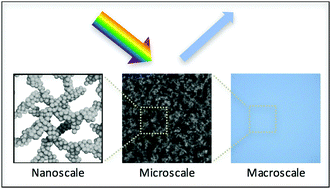Thermally reversible nanoparticle gels with tuneable porosity showing structural colour†
Abstract
We present colloidal gels formed from dispersions of PEG- and PEG+DNA-coated silica nanoparticles showing structural colour. The PEG- and PEG+DNA-coated silica colloids are functionalized using exclusively covalent bonds in aqueous conditions. Both sets of colloids self-assemble into thermally-reversible colloidal gels with porosity that can be tuned by changing the colloid volume fraction, although the interaction potentials of the colloids in the two systems are different. Confocal microscopy and image analysis tools are used to characteraize the gels’ microstructures. Optical reflection spectroscopy is employed to study the underlying gel nanostructure and to characterize the optical response of the gels. X-ray nanotomography is used to visualize the nanoscale phase separation between the colloid-rich gel branches and the colloid-free gel pores. These nanoparticle gels open new routes for creating structural colour where the gel structure is decoupled from the form factor of the individual colloids. This approach can be extended to create unexplored three dimensional macroscale materials with length scales spanning hundreds of nanometers, which has been difficult to achieve using other methods.



 Please wait while we load your content...
Please wait while we load your content...